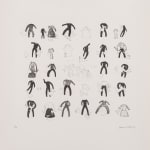

Johanna Calle Colombian, b. 1965
Untitled (Progeny), 2002
Lithograph
15.6 x 15.7 in
39.6 x 39.8 cm
39.6 x 39.8 cm
Edition 5 of 24
'This work is a stone lithograph made in the traditional way; to describe it in this way is not a redundancy, since today lithographic stones have been replaced by grained...
"This work is a stone lithograph made in the traditional way; to describe it in this way is not a redundancy, since today lithographic stones have been replaced by grained aluminum plates. Lithography is an ancient engraving technique (invented by Senefelder at the end of the 18th century) that has fallen into disuse. It is an engraving in which a polished stone plate is used. This can be seen in the characteristic marks that leave the irregular edges of the stone, engraved on the paper. The limestone is very fragile and quite heavy, making it difficult to manipulate. It is said that lithography is one of the techniques most faithful to drawing since it manages to reproduce subtle water qualities and gaps that are not achieved with other graphic techniques. Regarding the theme, I registered some of the figures collected under the title Progeny of 1999. In this series I wanted to represent relations of power between male and female figures and between children and adults. There are allusions to interfamily violence and abuse in the family nuclei." -Johanna Calle


